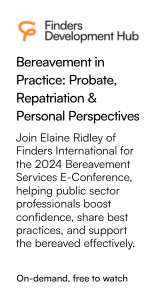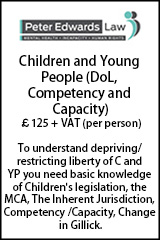Recognition of authority to place a looked after child in Scotland
- Details
Justin Gray looks at potential solutions to some of the ongoing challenges local authorities face in seeking to place looked after children in Scotland.
I began my article in Local Government Lawyer dated 10 January 2020 by praising the considerable number of high-quality residential accommodation resources in Scotland, and noting that these are often used by English local authorities to house and treat looked after children who are otherwise difficult to place. When the Children Act was drafted in the 1980s the availability of children’s homes throughout the UK was wholly different, and it would have been impossible for the architects of the Act to contemplate the complex and therapeutic needs of children in the 2020s and the geography of resources that might meet those needs.
Whilst there have been welcome developments, there remain several legal obstacles to local authorities placing looked after children in Scotland:
- The Children Act 1989 does not extend to Scotland, save in very limited circumstances. Legally, Scotland is a different country, and orders of the Family Division of the English High Court or of the Family Court have limited enforceability.
- An English care order does not take effect in Scotland as its Scottish equivalent – a compulsory supervision order – unless the formal transfer process is completed pursuant to the 2013 Regulations, or as of June 2022 if the child is subject to a deprivation of liberty authorisation made by the High Court.
- Recognition and enforceability of an English child’s status in Scotland is further limited by the absence of any reciprocal arrangements in relation to interim care orders.
- The invocation of the nobile officium by the Court of Session may have reached its limit, given its clear purpose of remedying only unforeseen and accidental gaps in legislation. This has been reflected in the decision of the Scottish Government in 2022 to take legislative action to reduce the number of petitions on what is supposed to be an exceptional remedy.
- The approval process pursuant to Schedule II paragraph 19 (i) only applies to long-term placements, (ii) has limitations when the child objects to a residential placement, and (iii) in any event would merely authorise the English local authority’s decision-making in its own jurisdiction rather than give the child a status in Scotland.
- The Care Inspectorate, the Scottish government agency responsible for ensuring care standards in Scotland, requires Scottish children’s homes to be satisfied that the placement in Scotland has been authorised by an English court.
Points (a) and (c) have been considered at length in Re X & Y [2016] EWHC 2271 (Fam) and Re H (Interim Care: Scottish Residential Placement) [2020] EWHC 2780 (Fam). I addressed point (d) in my article in Local Government Lawyer on 5 August 2022. Points (b), (e) and (f) are discussed further below, with a suggested solution thereafter.
The 2013 Transfer Regulations are a rarely used mechanism for the English care order to take effect as a Scottish compulsory supervision order, and therefore to be an order that is recognised and enforceable in Scotland.
- In the writer’s experience, it is common practice for English authorities to prefer to retain responsibility in spite of a move of the child to Scotland, for example for the sake of consistency of workers, and links with remaining family in England including contact arrangements.
- That preference is supported by the experience of others that Scottish authorities are rarely willing to take on responsibility for an English child that has moved to live in their area.[1]
- Neither the 2013 Transfer Regulations nor the Children Act 1989 Guidance Volume 2: care planning, placement and care review indicate that an English authority must or should seek to transfer responsibility to the equivalent authority in Scotland. It is merely there as an option.
Of course, a care order provides the Local Authority with the power to place a child in its care or interim care in England, Wales, Scotland or Northern Ireland without recourse to the court or the need for Schedule 2 paragraph 19 approval. This is the argument I referred to in my January 2022 article, which subsequently came to be approved in Re H. Approval of the Family Court is required if the arrangements for the child are for him to live in Scotland, rather than to be temporarily placed there. As matters stand, there has been limited judicial guidance as to how these two classes of placement are to be distinguished.
From the Scottish perspective, the Care Inspectorate’s June 2022 guidance informs the children’s homes that it regulates:
“As specified in the provisions of the Children Act 1989 and other relevant legal provisions:
- A young person subject to a care order from England or Wales may only be placed in residential accommodation out with England or Wales following a judgment that authorises this placement into a Scottish care service.
- Where required by law, the young person must also consent for this to happen but the Court can dispense with consent in certain circumstances, such as where the child cannot consent or withholds consent unreasonably.
- Alternatively, where the law provides that some other person, such as a person with parental rights must consent to the placement, this must also have been provided.
We expect services to always, and only, accept the admission of a young person where the placing authority’s decision is legally compliant in the jurisdiction in which the placing authority operates. It is the responsibility of the provider to be clear on the legal status of all young people they are caring for. We therefore expect residential services looking after a young person subject to a care order from England or Wales to have written evidence of the court judgment that authorises a placement out with England or Wales. This should include the young person’s consent, any other relevant consent, or a Court judgment dispensing with the need for this consent.”
It is not for English judges, let alone English lawyers, to suggest that the Care Inspectorate’s guidance ought to be altered or updated, to reflect the difficulties that might arise in securing an order in line with this guidance, for example where:
- The child is looked after by a local authority but not subject to a Part IV order;
- The placement is temporary, and so is a matter for local authority decision-making rather than the Family Court.
In Re H, Cobb J was satisfied that section 100(2) does not preclude the court from exercising the inherent jurisdiction “where the child has been accommodated voluntarily by a local authority with the consent of the parent(s), where that consent has not been withdrawn” and that in event that he was wrong in his analysis about the application of section 33(7) then the inherent jurisdiction could be used. I am quite sure he was not wrong about section 33(7), although it is far from clear how the High Court might be satisfied that the section 100(3) criteria are satisfied if it is the Local Authority seeking permission to seek to invoke the inherent jurisdiction in relation to children.
It is well established that the ambit of the High Court’s inherent jurisdiction as a remedy in relation to children’s welfare is available only where the statutory law does not extend. The inherent jurisdiction in relation to children cannot be used to override a statutory scheme, particularly where that might be in the context of the statutory scheme providing an unsatisfactory outcome, as was the case in in A City Council v LS & Others [2019] EWHC 1384 (Fam).
In contrast to Re X & Y and Re H, the inherent jurisdiction was not identified as a mechanism to authorise the placement of English children in Scotland in Re C [2019] EWCA 1714, probably because:
- The child in Re C was subject to a full care order, not an interim care order, and there is no statutory mechanism for interim care orders to be recognised in Scotland, beyond the enforcement of a recovery order.
- Schedule II paragraph 19 is a clear and detailed statutory structure for determining whether children in care should go to live abroad.
- There is a statutory structure for the Scottish authorities to be able to deal with and support children subject to English care orders who go to live there.
So what is to happen when the statutory structure for full care orders to be recognised and/or enforced in Scotland does not enable an English court to make an order in line with the Care Inspectorate expectations? Instances include cases where:
- the English local authority wishes to retain responsibility, and/or
- the Scottish authority local to the placement declines to accept responsibility, and/or
- the English Family Court is unable to approve the move to live in Scotland pursuant to Schedule II paragraph 19 due to a lack of consent, or
- Schedule II paragraph 19 does not apply, for example where there is no ground for such an application because the move is temporary and the child would not be going ‘to live’ in Scotland.
The problem may simply be that Schedule II paragraph 19 has not been updated since 1989, when:
- there might have been less mobility of children in care around not only the jurisdiction, but also the UK,
- local authority in-house and other resources were less stretched,
- there may have been fewer specialist therapeutic placements in Scotland than there are now, and
- the ‘crisis’ in relation to supply of such placements in England was less acute.
Children Act 1989 Section 100 is clear throughout that it relates to the ‘inherent jurisdiction in relation to children’ and is under the heading “Restrictions on the use of wardship jurisdiction”. Accordingly the restrictions set out in subsection (2), and the requirement of permission in subsection (3) and the relevant threshold to be met before permission might be granted in subsection (4), do not apply to the inherent jurisdiction to grant declaratory relief.
In order to meet the Care Inspectorate’s requirement that there be an English order authorising the placement in Scotland, the way forward may be to obtain a High Court declaration, rather than an order pursuant to Schedule II paragraph 19 or the inherent jurisdiction relating to children.
A declaration using the High Court’s inherent jurisdiction to grant declaratory relief would have no more weight or effect than a declaration or order pursuant to the inherent jurisdiction in relation to children, as those affected are in Scotland and the High Court’s writ does not extend to Scotland: the exercise of powers pursuant to either inherent jurisdiction cannot direct or empower a person or institution in Scotland, but can be used as evidence or authority that the English Court has approved the placement, as required by the Care Inspectorate.
Justin Gray is a barrister at Trinity Chambers.
[1] [2021] Fam Law 694 (May)











































